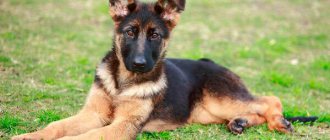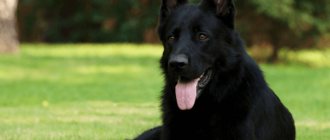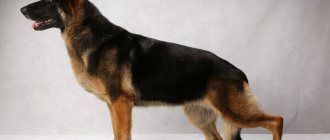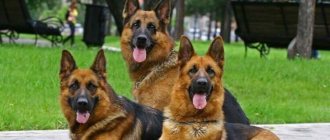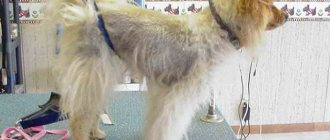A puppy's small age does not mean that he needs less attention and training.
Especially when it comes to German Shepherds.
This breed can become a true friend and protector.
But only if you start caring for and training him from a young age.
But this also has its own characteristics.
Let's find out about everything in detail.
Further in the article, detailed information on the care and education of a puppy will be provided.
What does a German Shepherd puppy look like at 3 months old?
At three months of age, a German Shepherd puppy begins to look more and more like an adult dog. His ears begin to stand up, his color gradually changes, his limbs begin to stretch out - his hind legs and large joints on his front legs grow.
The dog's tail also becomes more visible. The ears may still fall funny to the side, but most of the time they are now in an upright position.
At the same age, the puppy begins to shed.
In appearance, the dog still seems clumsy, parts of the body are disproportionate . This is due to the fact that the dog is entering adolescence and his body is just beginning to form.
This type of puppy indicates that maturation is in full swing. Over time, the awkwardness of his features will smooth out and cease to be so noticeable.
Weight gain norms by age
German Shepherd puppies take a long time to grow; the dog stops growing only at two years; the animal’s development will last up to three years. Normally, the weight gain of a shepherd cub by month is as follows:
- 1 month – from 2.5 to 4 kg;
- 2 months – from 6 to 9 kg;
- 3 months – from 10 to 16 kg;
- 4 months – from 15 to 20 kg;
- 5 months – from 18 to 26 kg;
- 6 months – 19 to 28 kg;
- 8 months – from 20 to 32 kg;
- 1 year – from 21 to 37 kg;
- 2 years – from 22 to 40 kg.
The weight of an adult German Shepherd is about 40 kg. By tracking weight changes over months and comparing them with the norm, we can conclude whether the dog is eating enough. Deviations from the norm are allowed within 15% of the given indicators.
The greatest activity in weight gain is observed in 1 month of life. 3 months after birth, the cub weighs three times more, and after a month it is already five times more.
Dog character
Despite the beginning of maturation, the puppy still remains a mischievous child by nature.
He plays pranks with pleasure and prefers to play rather than listen to his owner and be trained . This is the time when you need to be persistent and show the puppy that he must obey his owner.
Things in the apartment - furniture or shoes - can suffer from the dog's behavior. Therefore, it is important to walk the dog as much as possible in special areas where the puppy can throw out all the hyperactivity.
This behavior is explained by post-vaccination quarantine . Once it comes to an end, it will be easier to deal with the dog.
Three months is the right time to teach your dog to react to passers-by, guests and other dogs. This will help build the dog's balance.
But you shouldn’t take her to places where there are a lot of loud and frightening sounds - the puppy’s psyche has not yet fully formed, such an environment can contribute to the dog becoming nervous and fearful.
What should be the diet, sample menu for the day
Since from two months the puppy is transferred to 4 meals a day, the approximate daily diet (how much a puppy should eat per day) on natural products will be as follows.
Morning
Cereal porridge + milk mixture or broth + cottage cheese (kefir, yogurt, etc.) + peeled apple, chopped in a mixer, finely grated raw carrots + 1 tsp. brewer's or nutritional yeast. Total – 2 coffee cups.
Noon
Meat products, cut into pieces (useful for the development of jaws, chewing muscles and neck muscles) + broth with 1 tsp. seaweed flour or calcium carbonate (chalk). Total - no more than 250 g.
Afternoon
2 coffee cups broth-soaked puppy biscuits.
Evening
Raw meat products (the puppy will sleep better) + broth or mixture. Total – 1.5-2 coffee cups.
To be sure of a sufficient amount of necessary substances, it is enough to inject the drug Gamavit (a complex effect on biological processes with a wide content of vitamins and minerals) once every 10 days or give Fitocalcevit.
Pet's height and weight
Even at such a young age, the first developments between boys and girls of the German Shepherd begin to take shape..
The height of a male at 3 months is 42-48 cm, and his weight is 14-14.2 kg. For a female, these indicators are as follows: height – 40-46 cm, weight – 12-12.3 kg.
Read more information about the height and weight of the German Shepherd here.
Although there is no noticeable difference in height, as can be seen from the parameters, the weight of puppies of different sexes differs significantly from each other.
CAREFULLY!
Deviation from standard indicators may be the beginning of any diseases or deviations in the puppy’s health.
If you notice a lack of weight or height, it is better to contact your veterinarian.
When can a puppy be given complementary foods?
Two weeks after birth, you can start feeding the puppies. During this period, they are still breastfed, but for full development, the babies’ bodies need new nutrients. At 14 days they can be given minced lean beef, finely chopped and scalded tripe or heart, rice porridge with milk mixed with water in a 1:1 ratio. At three weeks the German is fed cottage cheese, yogurt and kefir. At four weeks, hard-boiled eggs are added to the diet. Vegetables, berries and fruits are given in small quantities.
For the first time, complementary feeding should be 15-20 g, which corresponds to half a tablespoon. In the future, the rate of any food fed per day should gradually increase:
- at 2.5 weeks – 100 ml;
- at 3 weeks – 150 ml;
- at 4 weeks – 200 ml.
What is better – natural or dry food?
Every owner thinks about which food is best for a pet. The debate over natural food and dry food never subsides.
Each of these foods can meet the needs of the puppy, the main thing is to follow the most important instructions in feeding the dog:
- When choosing dry food, opt for premium or super-premium class;
- Try to choose food for your breed;
- The food must be suitable for the dog’s age;
- If you choose natural food, the dog’s diet should be balanced;
- Natural food will require special vitamins;
- You must approach the choice of products responsibly: buy only fresh ones, exclude those that will harm the dog.
Expert opinion
Kozhevin Semyon Kirillovich
Expert dog handler.
“Food for a puppy of this breed is a very important matter. I know that many owners who are professional breeders choose natural food, believing that it is healthier for the dog. But they have enough time to cook and buy all the necessary products. People who get a German Shepherd “for the soul, and not “for business”, prefer dry food. If the dog's nutrition is correct, then no matter what type of food you choose, the dog will be happy."
What to feed in old age?
The dog should be switched to a gentle diet from the age of 6-7 years, depending on its state of health. Preference should be given to foods and feeds high in vitamins C and E , as they support the health of an aging dog and slow down the deterioration process of the body.
The calorie content and size of food should be reduced over time, but the amount of protein-rich foods can be increased by 20-25%. When feeding dry food, you should switch to types intended for older shepherd dogs.
Which feeding method to choose for a German Shepherd is a personal decision for each owner, which should be based on the needs of the dog and, to some extent, on its taste preferences. If a shepherd dog refuses to eat buckwheat, it is easier to try other types of cereals than to adamantly insist on his own.
You should always monitor your dog's activity and behavior. Proper nutrition is the key to a healthy life. And in this matter, the pet can only count on the responsibility of its owner.
Basic feeding rules
Rules to follow when feeding a German Shepherd:
- To keep your puppy healthy, it is important to follow certain rules when feeding it;
- Food should be warm, not hot, and not from the refrigerator;
- There should be no large pieces in the bowl so that the puppy does not choke - German shepherds do not chew food, but swallow it immediately;
- You need to feed your dog at the same time, regularly;
- You cannot overfeed your dog. This can lead to dehydration and volvulus;
- The puppy should always have clean drinking water available.
Nutrition for dogs prone to allergies
Food allergies in a German Shepherd can be caused by:
- dry food with artificial additives;
- chicken eggs;
- red vegetables and fruits;
- mussels, shrimp and other seafood.
Before allergens are identified, Germans are fed white sea fish, lean beef, turkey, oatmeal, buckwheat or rice porridge, natural dairy products, fruits and green vegetables.
Feeding with natural food
Your dog's menu should include a variety of grains, fruits, vegetables and meat.
Pork should not be given to your German Shepherd as it can lead to obesity..
At 3 months, the menu should contain as much meat as possible. Protein is the basis of growth for a growing organism. The menu should also include cereals and vegetables - carbohydrates and fiber.
The best choice of meat is lean beef - raw or boiled . The meat should be finely chopped; it is not recommended to give minced meat: it forms pieces and is not completely digested.
The puppy can also eat chicken, rabbit and turkey. It is better to give eggs with porridge and not very often.
The puppy will like meat broths . They can be added to cereals instead of milk.
You can give large beef bones that are difficult to chew. Chicken can damage the dog's oral mucosa.
Suitable cereals for a German Shepherd include buckwheat, rice, millet, rolled oats and semolina. It is better to give vegetables raw: this way they will not lose their vitamins.
But it can also be boiled as a filler for porridges. Suitable ones include beets, tomatoes, zucchini, cabbage, cucumbers and others. And the puppy will like berries and apples - they can be added to cottage cheese.
Fermented milk products on the shepherd's menu should include low-fat kefir, cottage cheese, curdled milk, yogurt, and fermented baked milk . It is better to avoid foods with high fat content.
How and how much to feed
Meals at the age of three months should be four times a day. The volume of food for each feeding should be 300-400 g.
The feeding process should not exceed fifteen minutes.
If there is food left in the bowl, reduce the portion. If, on the contrary, the dog licks it, this is a reason to think about increasing it. In any case, this must be agreed with your veterinarian.
Prohibited Products
Since dogs, and especially puppies, do not digest starch and lactose well, it is better not to give potatoes and milk at all. Like other dogs, German Shepherds cannot eat anything fried, smoked, pickled, sweet or floury.
Eliminate various sausages and poultry bones.
To avoid disturbing your dog's digestion, do not feed him food from the table..
Vitamin supplements
To prevent your puppy from developing vitamin deficiency, do not forget to give him fresh greens - parsley, green onions, lettuce, spinach, beet and carrot tops, scalded nettles.
For these purposes, both sprouted oats and sprouted millet are suitable in an amount of no more than one tablespoon per day.
Mineral supplements you can offer your puppy include meat and bone meal and crushed shells . For proper hair growth, pharmaceutical sulfur is given, and yeast is given for digestion and appetite.
You can give your pet special vitamins and granules, but before doing this you should consult a specialist.
General recommendations
Any dog is not only a predator, but also a scavenger . Puppies in nature gain independence by 4–5 months, receiving mostly leftovers after a successful pack hunt. And these are not fillet pieces, but cartilage/bones and connective tissue that help animals grow.
Domestic dogs are pampered with chicken breasts, fillets and tenderloins, which contain a lot of extra amino acids that are harmful to the dog’s body: they are poorly digested or stored as fat, and sometimes provoke allergies (protein poisoning). The tender pulp contains almost no building materials for the formation of bones, joints and ligaments, which is why first-class meat should be replaced by offal and trimmings with cartilage, veins and even skin particles.
Important! Don’t be afraid to feed your puppy raw meat because of the risk of infection with Giardia, Salmonella, viruses, roundworms, etc. A dog's stomach juice neutralizes not only pathogenic microflora, but also cadaveric poison. You should also not be afraid of antibiotics and hormones, which are occasionally found in meat: these are extremely unstable compounds that have time to decompose before it gets into the bowl.
In the wild, the puppies get their own food, and until they learn how to do this, they live from hand to mouth, content with what the adult tribesmen leave. If you're lucky, the puppy eats the carrion, as often happens in a wolf pack: the younger ones find what the older ones have hidden. Along with rotten game, growing dogs get rodents, lizards and insects (if they catch them), as well as berries, roots, carrion and manure.
Ready food or natural food
When thinking about what to feed your German Shepherd puppy, choose BARF, which normalizes the gastrointestinal microflora responsible for immunity. Dogs fed porridge with boiled chicken or fed industrial food have a noticeably weaker immune system. By the way, a menu where carbohydrates predominate not only changes metabolism, but also has a bad effect on the dog’s nervous system, increasing inhibition processes. It is not surprising that a puppy placed on BARF becomes more energetic and even aggressive.
This is typical for a growing organism receiving proper nutrition . You just need to increase the time for walking and playing. Puppies, as a rule, willingly eat raw foods, but sometimes become capricious, refusing unfamiliar ones. In this case, a new ingredient is mixed into the tested one or a slice is placed in the mouth and closed, waiting for the puppy to swallow.
This is interesting! A healthy puppy (due to rapid growth and an undeveloped satiety center) is always hungry, and refusal to eat signals illness or overfeeding. In the second case, he is separated from the bowl for a couple of feedings or the ration is reduced by 1.5–2 times.
A German Shepherd puppy with a natural diet receives all trace elements/vitamins from fresh chopped vegetables/fruits (plus berries/greens) and raw meat products. Industrial vitamins, especially water-soluble ones, are highly undesirable as they are easy to overdose on. If you consider it necessary to feed your puppy with them, give half the dose, adhering to the course interval.
Pedigree feed lines
Let’s assume that when answering the question of what to feed your German Shepherd puppy, you leaned toward ready-made factory food (due to your own laziness, being busy at work, or simple irresponsibility). You will have to choose a commercial diet with all seriousness, remembering that your puppy’s bone structure continues to form, which means that economy and premium food stuffed with grains is contraindicated for him.
Holistic products under the Acana and Orijen brands (with high nutritional value and good meat content) occupy the first positions in the domestic ranking of ready-made feeds.
The following foods are recommended for puppies:
- Acana Puppy Large breed;
- Innova Puppy Dry Puppy Food;
- Orijen Puppy Large;
- Acana Puppy Small Breed;
- Nutro Ultra Holistic Puppy;
- Chicken Soup For The Puppy Lover's Soul;
- Innova Large Breed Puppy Dry.
Important! If raw cartilage and bones are not on your pet's menu, you will need to supplement the diet with calcium supplements (preferably in the form of calcium chelate/citrate). Dog breeders appreciated Welpenkalk (Canina) and Irish Cal (Beaphar).
What not to feed German Shepherd puppies
The udder, lung, and especially beef liver, which often causes diarrhea, are prohibited.
The following are also recognized as dangerous and unnecessary products:
- bones after heat treatment and tubular;
- bread, pastry and sweets;
- fried foods;
- spices and herbs;
- legumes and cabbage;
- plum and grapes;
- ketchup and mayonnaise.
From 1 to 2 months, a German Shepherd puppy is fed 5-6 times a day every 3-4 hours (with a break for sleep), increasing portions as the pet grows . From 2 months they switch to 3-4 meals a day, from 3 months they feed three times a day. From six months onwards, the feeding regimen resembles that of an adult (twice a day), with the proportion of animal proteins reduced to 3–5% of the shepherd’s weight. Remember that overfeeding (overloading undeveloped ligaments/joints) is harmful for puppies, which causes dogs to become raw and loose.
Checking your puppy for allergies
A considerable part of breeders are convinced that German Shepherd puppies from 4 to 8 months should be fed extremely moderately, observing specific requirements for protein components.
Otherwise, the program designed by nature fails, and the owner raises a dog that is poorly adapted to life, with low immunity and susceptible to allergic reactions (including food ones). If your puppy’s diet is as varied as possible, that’s great, but the downside of a rich menu is intolerance to one of the ingredients.
Important! To understand what product the body rejects, you need to keep your shepherd dog on an elimination diet. At the same time, you will figure out whether the irritant is really in the food: perhaps the allergy is associated with other factors.
There are several types of such diets, designed both for puppies who are accustomed to dry food, and for their peers who specialize in a raw food diet. Adherents of natural feeding identify food irritants according to the following scheme:
- For a month, the puppy is given one unfamiliar type of meat (lamb, venison, fish, etc.), adding a single carbohydrate side dish (rice, potatoes, rolled oats).
- In case of a normal reaction, a new ingredient is introduced every 1–1.5 weeks; if an undesirable reaction occurs, the product is excluded, waiting for the symptoms to subside.
- So, step by step, month after month, they build up a dog diet that is guaranteed to protect the puppy from allergic manifestations.
Fans of dry industrial diets should follow a similar algorithm, only using food with hydrolyzate for their shepherd dogs, where the proteins are crushed and practically digested. Hydrolysis transforms protein components almost into a related organism: it ceases to identify them as foreign and does not give an allergic reaction.
Many companies produce products with hydrolyzate, so choosing a safe diet is not a problem. However, we must take into account that these foods contain not only protein components (soy, chicken), but also many additives. This is why food with hydrolyzate cannot be considered a panacea: they are also introduced into the diet gradually, observing how the pet reacts.
In addition, with any elimination diet it is prohibited:
- feed with treats during training;
- allow eating food found on the street (if the puppy does not understand, put a muzzle on him);
- arrange snacks and give supplements to the norm;
- treat with pieces from the master's table;
- change your dog's cosmetics.
Return to content
Feeding dry food
How to choose?
When choosing food, immediately exclude all cheap ones. They will not be able to provide the puppy with all the vitamins and nutrients necessary for growth and development. Very often, abuse of such feeds leads to diseases in animals. The kidneys, liver and stomach suffer.
IMPORTANT!
You need to buy premium or super-premium food. They are not cheap, but they will help save a lot of time and will not harm the dog’s health.
If there is a lack of calcium, the puppy's ears begin to fall off..
Popular manufacturers:
- Acana;
- GO Natural;
- Grandorf;
- Orijen;
- Dukes Farm;
- Bosh;
- Eukanuba;
- Arden Grange.
How often to feed
Feeding your dog, as with natural food, is 4 times a day..
It is advisable to do this after a walk. Then let the puppy rest for several hours so that the food is digested.
What cereals are good for puppies?
Carbohydrates are involved in the metabolism of nucleic acids and are necessary for the dog’s body for normal protein and lipid metabolism. The main source of carbohydrates is cereals. Porridge is cooked in water for pets.
Cereals recommended for puppies:
- oats, large flakes should be steamed with boiling water rather than boiled; The rice is cooked crumbly (1 cup of cereal and 2 cups of water). If a dog has diarrhea, “slimy” rice water helps;
- buckwheat: in allergic dogs it can in rare cases cause an undesirable reaction in the form of itching and diarrhea;
- Semolina is fed to weakened and exhausted dogs for accelerated restoration of strength due to its calorie content.
You cannot feed your puppy pearl barley, millet, barley and corn cereals. Wheat is a highly allergenic grain and requires a careful approach.
Do I need to get vaccinated at this age?
The only vaccination that should be done after three months is against rabies. All other vaccinations are distributed throughout the dog’s life so that nothing serious occurs at this age .
Vaccinations have either already been done or the deadline for them has not yet come.
But sometimes it happens that the puppy’s second vaccination falls at three months. It depends on the age at which the first one was performed.
How much food should I give my kitten?
The dosage of dry food depends on its quality. Super-premium products contain all the necessary elements, which allows them to surpass natural food in nutritional value. It is economical, the portions are small, the size depends on the purpose of raising the German Shepherd, the weight of the parents and the intensity of the pet’s development.
You can find out how much dry food you should give your puppy at different ages from the table:
| Age in months | Puppy weight | Feed quantity |
| 2 | 7.6 kg | 240 g |
| 4 | 13.5 kg | 310 g |
| 6 | 18 kg | 350 g |
| 8 | 26 kg | 428 g |
| 10 | 35 kg | 432 g |
Caring for a three month old puppy
Three months is the age when walking the dog should be in full swing. The first walks should not exceed five minutes, then gradually increase to 30-40 minutes.
If at first you need to hold the puppy in your arms, then teach him to walk on his own, make sure that he does not pick up anything from the ground.
Train him to use a leash, because large dogs like the German Shepherd cannot be walked without a leash, no matter how well trained he is.
NOTE!
A full walk should consist of communication with peers, games and jogging.
At this time, the puppy should know some commands and get used to using the toilet outside.
Dog hygiene consists of brushing, which should occur 1-2 times a week, cleaning the ears and trimming the nails . Puppies should be bathed when the smell begins to appear or as they become dirty.
Feeding a newborn puppy
If the bitch is healthy, she will feed the cubs herself. You just need to take care of the timely start of complementary feeding from three weeks of age, so that by the time they are weaned, the puppies can feed themselves. But when the mother died during childbirth or shortly after, her milk disappeared, and hard work lies ahead in caring for the newborns.
To understand the depth of the problem, let's compare the composition of dog milk with possible substitutes. The bitch's milk is thick, the amount of dry matter is twice that of human and store-bought milk. The percentage of proteins to fats and carbohydrates in the milk of bitch 1: 0.8: 2.3; cows - 1: 0.9: 0.5; women - 1: 0.25: 0.15. Therefore, infant formula is not at all suitable for puppies.
The following artificial formulas for puppies have been adapted from cow's milk:
- Add a tablespoon of milk powder to a glass. This ensures that the consistency of dog milk matches that of dog milk. But the imbalance in carbohydrates and fats remains.
- Add egg yolk to half a liter of milk and mix thoroughly. Protein contains an anti-nutrient called Avidin, which destroys vitamin H.
The optimal solution is to purchase a bitch milk substitute. The most budget option is Beaphar lactol costing 974 rubles/0.2 kg.
For newborns, the dry mixture is diluted with hot water, but not boiling water, at the rate of 15 g (measuring spoon) per 50 ml. Allow to cool to 40 °C. The prepared mixture is suitable for drinking from a pipette for 24 hours, then from a bottle. The first few days the milk replacer is taken after 2, then after 3 hours. For two-week-old cubs, the number of feedings is reduced to 6, the mixture is poured into a saucer. Decide on the dosage yourself. I recommend feeding ad libitum.
When the puppy can drink from the dish, give Royal Canin starter or a similar food of at least premium quality at one of the feedings. Start with 1-2 croquettes, soaked with three times the amount of water.
Approximate price 1 kg - 600 rub.
Premium dog food ratings
By the age of one and a half months, the puppy’s diet should consist entirely of solid food. Reduce the amount of water for soaking gradually.
If you are a follower of natural nutrition, start feeding your German Shepherd puppy with boiled rice, cottage cheese, meat, and soups. You will have to learn how to create a diet, at least assess its nutritional value based on proteins.
You may know that the protein concentration in a puppy's diet should be 30%. Do not panic when it turns out that cottage cheese contains 75% moisture content 16; in beef 65% moisture content - 18; rice (14%) - 7%. If we convert to dry matter, we get 64; 50; 8%. Natural food contains, on average, about 30% dry matter. Therefore, the protein norm will be 30*30/100=9%.
Training and education
Three months is the time to start serious training, given that the dog has already learned the basic commands. These are “sit”, “lie”, “place” and “near”.
During the training process, you must not insult, humiliate or beat the dog..
She won't respect you if you are rude to her. Real authority can be shown without this, but the puppy will remember this and begin to fear you, not respect you. Trust cannot be built on fear.
Show the puppy that if he follows the command correctly, he will receive a reward, otherwise he will receive a reprimand . Also, before training, the dog should be in a good mood - he should not want to go to the toilet, not be hungry or overexcited.
Also schedule a time when you will do your workouts. You should always hold this time in the future so that the puppy gets used to it - it’s not time for games.
You also need to train in different places, not just in an apartment or in one place on the street. This way the puppy will understand that it is necessary to obey and carry out commands not only in one location.
In addition to the basic commands, the puppy must learn the commands “No”, “Fu”, “Bring”, “Own”, “Alien” . The dog easily gets used to the commands “Eat” and “Walk”.
It is the persistence and conscientiousness of the owner that determines how the dog will grow up. Owning a German Shepherd is a big responsibility.
Without training and education, it can become a great threat to others..
Vitamin supplements for puppies
The vitamin and mineral complex should become an integral part of the natural diet of the German Shepherd. Dogs can accept:
- nutritional yeast;
- fish fat;
- bone meal;
- vitamins A, E, D.
- sulfur
It is possible to use a ready-made vitamin complex, which a veterinarian will help you choose based on test results and observations of your German Shepherd puppy.
When using high-quality industrial feed, additional fortification is not required.
Prevention of hypovitaminosis
In the autumn-winter time, to prevent rickets, the puppy must be given fish oil, start with a few drops, gradually increase the amount to one tablespoon of fish oil per day. Instead of fish oil, you can give a complex of three vitamins: A, D and E. You can also replace fish oil with vitamins A, D in oil.
Learn more about how to stop your dog from peeing at home. Little tricks.
Don't know how to train your dog to use the litter box? Read about it here.
Table of daily norms and needs of different dogs
In order to determine the size of the food portion, you first need to know the dog’s weight, at least approximately. Regularly weighing your pet will help adjust this norm to a comfortable value so that the dog does not overeat and is full at the same time.
If we know the dog’s weight, we can use a table of daily food intake - such a table is always published on the official pages of food brands on the Internet and, of course, on each package. As an example, consider Blitz Adult Lamb & Rice food for all breeds.
In his table, in addition to weight, there is also an indicator such as activity, which must also be taken into account. After all, a dog with the same weight may have different energy needs: a 10-kilogram dog kept in apartment conditions will need 130 grams of food per day, but an active, mobile dog with the same weight will need more to replenish energy costs. 150–170 grams.
The energy needs of aging dogs are much more modest than those of young dogs. Age-related changes, which include a slowdown in metabolic processes, make the dog less active and prone to weight gain.
It is not necessary to look for special food for older dogs; besides, older pets often have established eating habits and may react negatively to a new taste. It is enough to simply slightly reduce the daily intake of your usual dry food.
Natural diet
“Natural” is more familiar to many experienced dog owners. It is believed that natural food is better and easier to digest by the dog’s body. By the way, manufacturers of industrial feeds do not argue with this fact, since the main “measure” of the quality of their products is the maximum proximity to natural food. The natural diet of the German Shepherd involves a varied diet of raw and cooked foods. Representatives of the breed are prone to food allegra and if your pet has such a disease, there are 2 options - identify and eliminate allergens from the diet or feed the dog hypoallergenic industrial food.
Authorized Products
Beef, lean pork (boiled), chicken, lean goose, turkey without bones, skin or fat. Meat by-products – trachea, tripe, heart, beef udder (boiled). It is advisable to exclude kidneys and liver only in small quantities.
Ocean fish is low-fat, boiled or raw after deep freezing. When feeding raw fish, you need to take into account its bony content. Ocean fish is only boiled, cleaned of bones.
Milk - provided that the product does not cause intestinal upset.
Dairy products – any, preferably natural without dyes or additives. Cottage cheese, both homemade (fat) and calcined.
Chicken and quail eggs - not every day. Raw (passed veterinary control), boiled, in the form of an omelet.
Cereals – optimally buckwheat and rice; if you are underweight, barley and wheat cereals; if you are overweight, barley; not often - oatmeal.
Vegetables – any that the dog likes in any form. Only fresh potatoes, boiled, stewed or stewed cabbage; corn only raw (including frozen semi-finished products), in small quantities.
Fruits – any, except exotic ones. If the dog loves citrus fruits and does not suffer from allergies - only as a treat, a little and rarely. Apricots, plums and peaches can cause diarrhea.
Berries – rowan, currant in small quantities.
Nuts and seeds – shelled pumpkin seeds, pine nuts, cashews; rarely - almonds.
Vegetable oils.
Additives – food yeast, bone meal, feed tricalcium phosphate, vitamin-containing oils (A, B, D), salt in small quantities.
Prohibited Products
Tubular and spiky bones. Only spongy bones are possible, but they do not provide any particular benefit; on the contrary, they harm the teeth of an adult dog. Moslaks are relevant only during the period of teeth change, like a toy.
Chocolate and any sweets and products containing sweeteners, especially xylitol.
Flour products – baked goods (especially yeast dough), pasta.
Sausage products and semi-finished meat products.
Semolina, corn porridge, millet.
Legumes are not harmful, but they are not beneficial. Peanuts are the only legume product that can be considered healthy (in reasonable quantities).
Grapes and raisins.
Walnuts, pistachios, acorns.
Any spices.
Emergency assistance in case of poisoning
If food poisoning is suspected, a starvation diet and sorbents that bind and remove the toxic substance from the body are recommended. This may be one of the following pharmaceutical drugs:
- polysorb,
- atoxyl;
- enetrosgel;
- white coal;
- Activated carbon.
To relieve spasms and vomiting, 2-3 ml of no-shpa (drotaverine) is injected intramuscularly, and after 30 minutes - 2 ml of cerucal (metoclopramide). Instead of water, the poison of medicinal herbs (chamomile, yarrow, oak bark) is drunk in fractions. For intestinal upset, use one of the following antibiotics:
- nifuroxazide;
- metronidazole;
- biseptol,
- chloramphenicol.
If the condition worsens and is accompanied by an increase in body temperature, the dog should be urgently taken to a veterinary clinic.
Views: 5,980
About the amount of food for a puppy and its proportions
There is endless debate about how much food to give a dog depending on its age. And this is justified, because all dogs have individual nutritional needs. The same food is digested differently even among littermates, due to different metabolisms, housing conditions, adherence to the schedule of vaccinations and deworming, and other reasons.
It is believed that 7% of a dog’s weight is the average daily food intake. These indicators are arbitrary: often, with the same weight, one dog can be very thin, a second can have excellent average weight gain, and a third can be obese.
It is very important for a puppy owner to learn to “see” his dog. Feel her mood, distinguish fatigue from the first symptoms of illness, observe her stool, the quality of her coat, be able to visually and by touch determine her fatness.
For any menu, the main factor is the ratio of nutrients: for any dog, the diet consists of 70% protein products (meat, fish, eggs, fermented milk and dairy products), 20% porridge, 10% vegetables.
Combined nutrition
A combined or mixed type of nutrition means a diet that includes natural food and industrial feed. Some owners prefer to feed shepherds this way, being confident that the pet receives only the most beneficial elements from the two types of food.
But experts believe that dogs should have a separate diet and mixing ready-made food with natural products only harms the dog’s health. The fact is that dogs’ bodies require different periods of time to digest dry granules and regular food.
Natural foods are digested within two to three hours, while the body spends two to five hours processing industrial feed. And when mixing granules with porridge or vegetables, natural products will enter the intestines within two hours, and the dry food remaining in the stomach will swell and the fermentation process will begin, which will lead to bloating.
Therefore, a combined type of nutrition is only possible if you give the dog natural food in the morning and offer dry food to the pet in the evening. The daily food intake is calculated as follows: the volume of a bowl of natural food should not exceed half a liter, and no more than three hundred grams of dry food are given.
Vitamins
The importance of vitamins in the life of a shepherd cannot be overestimated. At each life stage, a pet requires its own set of nutrients.
- Up to one year old, puppies need supplements that strengthen bone tissue and promote the development of the cartilaginous plate of the ears. Calcium, phosphorus, vitamins A, B, C and E help with this.
- After a year, the animal’s food should contain: carotene, ascorbic acid, vitamins D and E, pantothenic acid, thiamine.
- After 6 years, the shepherd’s body wears out and chondoprotectors come to the fore. For a 7-8 year old shepherd, vitamin support is prescribed by a veterinarian.
- The pregnancy period also requires additional fortification with phosphorus, calcium, magnesium, folic acid and vitamin E.
